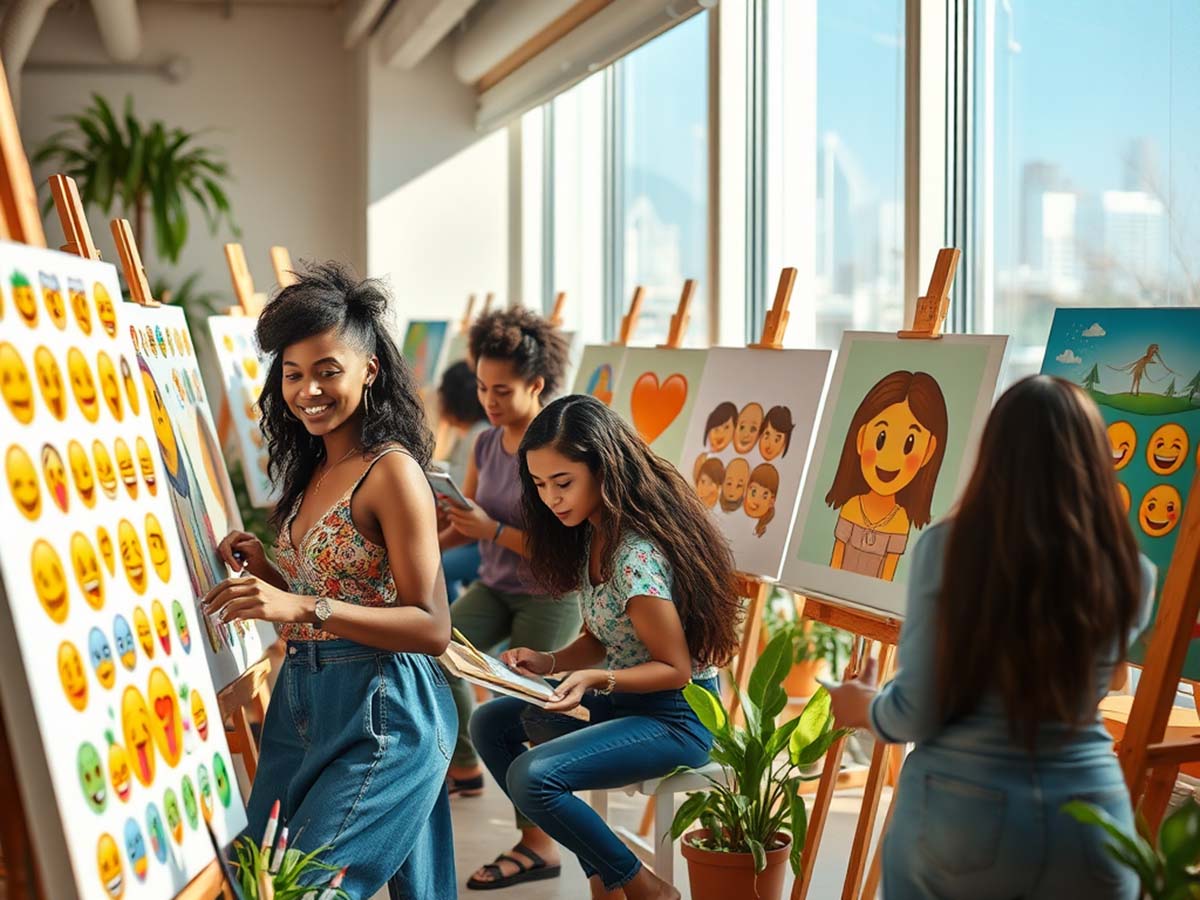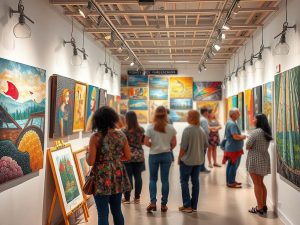
Modern creativity unites digital shorthand with classic visual practices. Meanwhile, creative minds reimagine marks once reserved for simple texting, transforming them into expressive motifs on canvas, installations, or sculptures. As a result, art reflects a fusion of updated technology with time-honored media, opening fresh avenues for personal as well as shared expression. For example, a single instance, emoji.now, provides extra insight into shifting artistic narratives. Each piece offers vibrant imagery, dynamic compositions, and unexpected juxtapositions that spark subtle sentiment while challenging long-held boundaries. In addition, visual storytellers harness basic signs to evoke deep emotion, thereby fostering dialogue among varied cultures. Consequently, every composition joins modern iconography with classic techniques, inviting audiences to reconsider established cultural narratives.
In turn, inventive experiments modify viewer perceptions and encourage active engagement. Next, new methods allow digital motifs to assume roles in sculptural forms alongside interactive exhibits. Ultimately, creative communities witness ongoing redefinition when longstanding practices mingle with contemporary symbols, thus producing works that mirror evolving societal expression.
Digital Language: The Journey of Emoji Symbols
Digital marks originally served basic communication needs; however, they have since evolved dramatically. In what follows, historical context and cultural shifts clarify how simple icons matured into a recognized visual language within art.
Historical Roots and Digital Evolution
Initially, rudimentary signs fulfilled practical functions. Early devices transmitted quick visual cues so that emotions could be expressed succinctly. Then, successive generations refined these marks, and what began as basic representations gradually acquired aesthetic potential. Consequently, early designs paved the way for icons that now articulate complex sentiments. In addition, rapid technical progress accelerated these modifications, resulting in symbols that carry layered meaning. Notably, the creative use of Unicode characters demonstrates how designers and artists have adapted digital symbols for expressive purposes. Subsequently, art creators seized reimagined signs and transformed them into elements of a broader visual vocabulary. Thus, technology and artistic expression merged, empowering innovators to reinterpret everyday symbols.
From Messaging to Art: A Cultural Shift
Soon after, casual messaging marks transcended their original contexts. At first, creative communities experimented by inserting these symbols into visual projects; later, cultural dialogues adopted them and assigned nuanced roles in artistic works. Then, critics recognized that such marks conveyed sophisticated ideas and provoked thought. As a consequence, each icon grew in cultural significance, linking minimal design with rich historical context. Next, public interest in these symbolic reinterpretations surged, prompting a fresh wave of artistic experimentation. Ultimately, marks once considered trivial now serve as powerful statements within modern visual narratives.
Artistic Integration of Digital Symbols
Creative communities continuously insert modern symbols into diverse media, merging digital cues with tactile techniques that defy established categories. In this section, inventive practices combine classical methods with contemporary iconography, producing artworks that both surprise and provoke thought.
Innovative Techniques and Mediums
Painters now transfer digital iconography onto canvases using hybrid methods that combine brush strokes with pixel-like textures. Meanwhile, sculptors experiment with unconventional materials crafted to mimic qualities typically found in virtual designs. In addition, installation artists incorporate interactive elements that convert static marks into kinetic expressions. Consequently, viewers encounter engaging displays that invite active interpretation instead of passive observation. Next, experimental studios generate vivid pieces that defy simple classification, thereby challenging conventional art traditions. At the same time, creators integrate digital cues with tangible elements; thus, their work cultivates dynamic narratives that encourage fresh perspectives.
Bridging Traditional and Digital
Artists often combine conventional craftsmanship with modern visual signals. For instance, some studios merge classical drawing techniques with digital prints, so resulting works exhibit fluid transitions between eras. Then, innovative approaches prompt observers to consider surprising visual juxtapositions. As a result, art now communicates using both physical texture and virtual design, making each piece multilayered and engaging.
Notable Examples in Contemporary Art
Galleries currently exhibit projects where digital symbols assume prominent roles within abstract compositions. In addition, critics praise installations that prompt reflection on the transformation of messaging and the recontextualization of everyday signs. Consequently, reviewers note that seemingly trivial marks now alter perceptions and stimulate dialogue regarding cultural values. Next, renowned exhibitions feature interactive displays where audiences contribute to evolving artworks, thereby highlighting community involvement. Moreover, several case studies underline how modern artists merge digital cues with traditional media. As a result, these innovative practices serve as testaments to a broader shift in creative circles, in which symbols evolve into instruments of rich narrative expression.
Cultural Impact and Artistic Expression
Minimal digital marks now generate resonance far beyond mere decoration. Creative outputs imbue these symbols with layered meaning, forging connections with diverse audiences. This section examines how such marks evoke emotion and spark social commentary while shaping global art narratives.
Emotional and Social Resonance
Artworks featuring digital marks frequently spark unexpected feelings among viewers. Initially, subtle shifts in design prompt connections to personal experiences; subsequently, nuanced alterations in form and color evoke complex emotions. Also, careful arrangements of visual elements produce a balance between simplicity and sentiment, causing audiences to reflect on shared memories. Then, observers discover that these minimal designs effectively bridge cultural divides while triggering engaging conversation. Consequently, critics report that each piece resonates deeply, stimulating reflection and inspiring social commentary that extends beyond conventional aesthetics.
Impact on Audience Interaction
Visitors often experience renewed interest when confronted with symbolic images. At first, thoughtful placements of digital marks create surprising focal points within artworks; later, such arrangements intensify audience engagement. In turn, interactive displays generate communal dialogue as individuals interpret layered meaning in varied ways. Ultimately, these dynamic setups encourage viewers to forge personal connections with artistic expressions.
Influence on Global Artistic Trends
International art scenes increasingly incorporate digital symbols to construct culturally relevant narratives. Previously, creative boundaries remained fixed; now, modern techniques allow for greater flexibility. Consequently, digital cues function as catalysts in art movements spanning continents. Next, emerging trends integrate local heritage alongside global visual signals, thereby forging links between distinct creative traditions. Then, critical reception from worldwide audiences underscores that integrating digital motifs expands artistic vocabulary. As a result, modern art now reflects varied cultural influences while embracing both historical and contemporary references.
Exploring Future Trends in Art and Digital Symbolism
Anticipated innovations indicate that creative circles will continue adapting digital marks in inventive ways. In this final section, advanced projects hint at augmented interactions between audiences and artworks, while emerging technologies and new approaches may soon reshape visual storytelling.
Emerging Technologies and Creative Possibilities
New interfaces promise to fuse tangible art forms with digital design in previously unforeseen manners. Initially, interactive screens and sensor-based installations invite visitors to become part of each artwork; subsequently, such displays transform static presentations into immersive encounters. Next, advanced systems employing artificial intelligence and machine learning contribute to artworks that adjust in real time. Consequently, viewers experience fluid displays that respond to their presence and input. At the same time, creative professionals experiment with hybrid techniques that blend programmed visuals with tactile craftsmanship. Thus, these setups introduce diverse sensory experiences that widen interpretive boundaries.
Integration of Real-Time Feedback
Projects increasingly incorporate audience responses to create dynamic pieces. At first, sensor arrays capture viewer behavior; then, artworks modify their appearance in response. Consequently, interactive displays provide personalized experiences that engage every visitor. In addition, such techniques generate a feedback loop that encourages sustained audience participation. Ultimately, these innovative systems point toward a future where creative works continuously evolve through direct viewer influence.
Potential for New Artistic Expressions
Future initiatives may blend physical artistry with digital finesse in groundbreaking ways. Initially, collaborations among traditional artists and tech experts generate projects that challenge old conventions. Then, experimental studios produce works that shift continuously, adapting to viewer interaction. Consequently, creative endeavors may transcend static representation, opting instead for fluid narratives that evolve with each audience encounter. At the same time, cross-cultural exchanges spur reinterpretations of familiar symbols, thereby paving the way for fresh creative languages. As a result, art becomes a living dialogue between tradition and modernity, inspiring both creators and appreciators alike.
Anticipated Shifts in Visual Storytelling
Artistic innovation likely will continue transforming visual narratives. First, blending digital cues with classical forms yields art that communicates in multiple dialects. Then, evolving techniques generate stories that mirror both technological progress and timeless themes. Consequently, future artworks may emphasize adaptability and interactivity while inviting deeper audience connection. In effect, each new project contributes to an ongoing conversation that reshapes artistic expression and cultural exchange.

